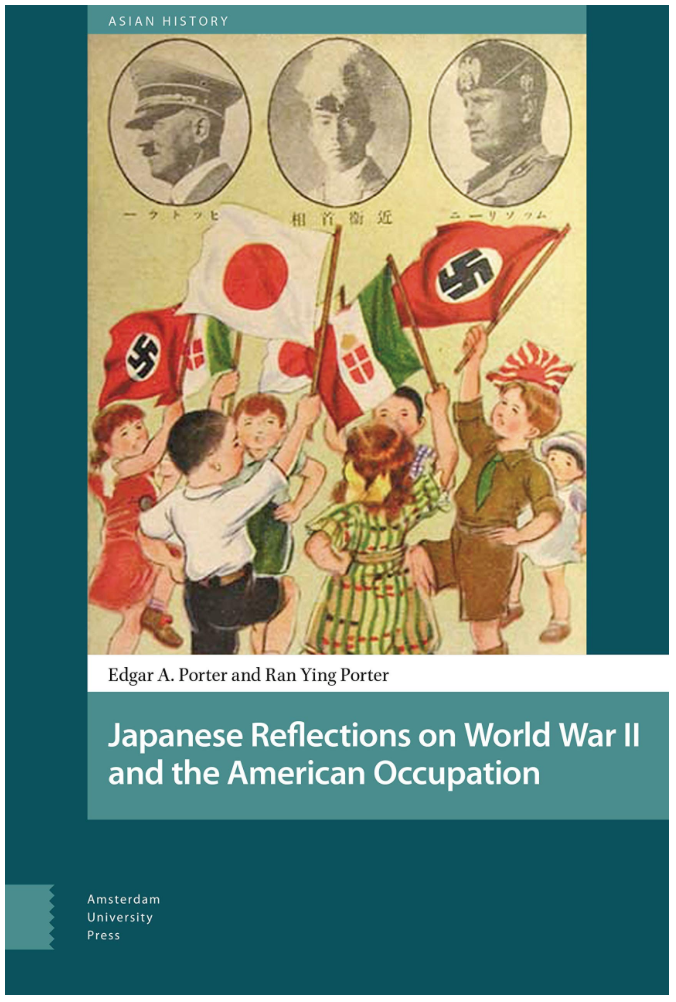[Edgar A. Porter & Ran Yin Porter, Japanese Reflections on World War II and the American Occupation. Amsterdam University Press. Amsterdam, 2017. 256 p.]
REVIEW / Rut Natalie Noboa Garcia
 World War II has provided much inspiration for an entire genre of literature. However, few works fail to capture Asian perspectives on the beginning, development, end, and consequences of World War II. Additionally, the attitude and outlooks of defeated parties are often left out of popularized discussions of conflicts. Because of these two factors, Japanese perspectives during the war and occupation have often served as only minor discussions in World War II literary work.
World War II has provided much inspiration for an entire genre of literature. However, few works fail to capture Asian perspectives on the beginning, development, end, and consequences of World War II. Additionally, the attitude and outlooks of defeated parties are often left out of popularized discussions of conflicts. Because of these two factors, Japanese perspectives during the war and occupation have often served as only minor discussions in World War II literary work.
This sets the stage for Edgar A. Porter and Rin Ying Porter’s Japanese Reflections on World War II and the American Occupation, which presents the experiences of ordinary Japanese citizens during the period. The book specifically focuses on the rural Oita prefecture, located on the eastern coast of the island of Kyushu, a crucial yet critically unacknowledged place in Japan’s role in World War II. Hosting the Imperial Japanese Navy base that served as the headquarters for the Pearl Harbor attack, being the hometown of the two Japanese representatives that signed the terms of surrender at the USS Battleship Missouri, serving as the place for the final kamikaze attack against the United States, and providing much of Japan’s foot soldiers for the conflict, Oita is ripe with unchronicled, raw, and diverse accounts of the Japanese experience.
The collective stories of the 43 interviewees, who lived through the war and occupation present the varied perspectives of soldiers, sailors, and pilots, who are often at the center of war discussions and experiences, but also that of students, teachers, nurses, factory workers and more, providing a multidimensional portrayal of the period.
The book begins with the early militarization of the Oita prefecture, specifically in Saiki, the location for one of the most crucial bases for the Japanese Imperial Navy. This first chapter features the perspectives of young Saiki citizens raised during the period who still see the Pearl Harbor attack with a conflicted yet enduring pride, setting the stage for following interesting discussions on Japanese post-war sentiment.
Another important aspect addressed by the Porters in this work is the mass censorship and indoctrination that took place in Japan during the war period. During this time, media censorship and military-based education helped to obscure the actual happenings of the conflict, particularly in its earlier years, as well as rallying the population in support for the Japanese navy. As well as presenting censored portrayals of the war itself, local Oita editorials both highlighted and encouraged public support for the war and the glorification of death and martyrdom. This indoctrination is also acknowledged by the Porters in relation to traditional Japanese Shinto beliefs on the emperor, specifically his divine origins. Japan's media portrayals of the conflict concerning to the state and emperor as well as its moral education curriculum feed into each other, applying moral pressure to the support of war efforts.
Japanese Reflections on World War II and the American Occupation also provides particularly interesting insights on East Asian regionalism, particularly from the perspective of Imperial Japan, which viewed itself as an “older brother leading the newly emerging members of the Asian family towards development” and promoted the idea that the Japanese were racially superior to other Asian ethnic groups. The first-hand accounts of many of the atrocities committed by Japanese in cities such as Nanjing and Shanghai as well as their glorification by the Japanese press add to the book’s depth and relevance.
As the war approached an end, conflict reached Oita. The targeting of civilians and the bombing of factories during American air raids lowered Oita morale. Continued air raids on Oita City, the prefecture’s capital city, rapidly fueled the region’s fear and resentment towards American soldiers.
In conclusion, Japanese Reflections on World War II and the American Occupation manages to present important first-hand accounts of Japanese life during one of the most consequential moments in modern history. The impact of these events on current Japan is particularly interesting when it comes to Japanese culture, especially when it comes to the glorification of war in Japanese education as well as the rising tide of Japanese nationalism.